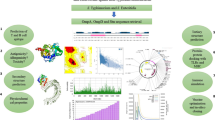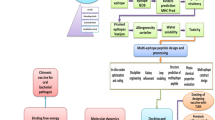Abstract
Trueperella pyogenes (T. pyogenes) is an opportunistic pathogen that causes infertility, mastitis, and metritis in animals. T. pyogenes is also a zoonotic disease and is considered an economic loss agent in the livestock industry. Therefore, vaccine development is necessary. Using an immunoinformatics approach, this study aimed to construct a multi-epitope vaccine against T. pyogenes. The collagen adhesion protein, fimbriae, and pyolysin (PLO) sequences were initially retrieved. The HTL, CTL, and B cell epitopes were predicted. The vaccine was designed by binding these epitopes with linkers. To increase vaccine immunogenicity, profilin was added to the N-terminal of the vaccine construct. The antigenic features and safety of the vaccine model were investigated. Docking, molecular dynamics simulation of the vaccine with immune receptors, and immunological simulation were used to evaluate the vaccine’s efficacy. The vaccine’s sequence was then optimized for cloning. The vaccine construct was designed based on 18 epitopes of T. pyogenes. The computational tools validated the vaccine as non-allergenic, non-toxic, hydrophilic, and stable at different temperatures with acceptable antigenic features. The vaccine model had good affinity and stability to bovine TLR2, 4, and 5 as well as stimulation of IgM, IgG, IL-2, IFN-γ, and Th1 responses. This vaccine also increased long-lived memory cells, dendritic cells, and macrophage population. In addition, codon optimization was done and cloned in the E. coli K12 expression vector (pET-28a). For the first time, this study introduced a novel multi-epitope vaccine candidate based on collagen adhesion protein, fimbriae, and PLO of T. pyogenes. It is expected this vaccine stimulates an effective immune response to prevent T. pyogenes infection.
Graphical abstract









Similar content being viewed by others
Data availability
The datasets [GENERATED/ANALYZED] for this study can be found within the manuscript and in the NCBI (https://www.ncbi.nlm.nih.gov/) with their accession numbers in this manuscript.
Abbreviations
- T. pyogenes :
-
Trueperella pyogenes
- PLO:
-
Pyolysin
- GRAVY:
-
Grand average of hydropathicity
- JCat:
-
JAVA codon adaptation tool
- PSSM:
-
Position-specific scoring matrix
- CAI:
-
Codon adaptation index
- TLR:
-
Toll-like receptor
- pI:
-
Isoelectric point
- MW:
-
Molecular Weight
References
Alvestegui A et al (2019) TLR4 participates in the inflammatory response induced by the AAF/II fimbriae from enteroaggregative Escherichia coli on intestinal epithelial cells. Front Cell Infect Microbiol 9:143
Ashrafi Tamai I, Mohammadzadeh A, Zahraei Salehi T, Mahmoodi P (2018) Genomic characterisation, detection of genes encoding virulence factors and evaluation of antibiotic resistance of Trueperella pyogenes isolated from cattle with clinical metritis. Antonie Van Leeuwenhoek 111:2441–2453
Ashrafi Tamai I, Mohammadzadeh A, Zahraei Salehi T, Mahmoodi P, Pakbin B (2021) Investigation of antimicrobial susceptibility and virulence factor genes in Trueperella pyogenes isolated from clinical mastitis cases of dairy cows. Food Sci Nutr 9:4529–4538
Baseer S, Ahmad S, Ranaghan KE, Azam SS (2017) Towards a peptide-based vaccine against Shigella sonnei: a subtractive reverse vaccinology based approach. Biologicals 50:87–99
Beikzadeh B (2023) Immunoinformatics design of multi-epitope vaccine using OmpA, OmpD and enterotoxin against non-typhoidal salmonellosis. BMC Bioinform 24:63
Beikzadeh B, Ashrafi Tamai I, Zahraei Salehi T (2023) Construction of live-attenuated Trueperella pyogenes by antibiotic treatment and sequential passage: methods for vaccine development. Arch Microbiol 205:147
Bibi S et al (2021) In silico analysis of epitope-based vaccine candidate against tuberculosis using reverse vaccinology. Sci Rep 11:1–16
Bukhari SNH, Jain A, Haq E, Mehbodniya A, Webber J (2021) Ensemble machine learning model to predict SARS-CoV-2 T-cell epitopes as potential vaccine targets. Diagnostics 11:1990
Carneiro LC, Cronin JG, Sheldon IM (2016) Mechanisms linking bacterial infections of the bovine endometrium to disease and infertility. Reprod Biol 16:1–7
Deliwala S, Beere T, Samji V, Mcdonald PJ, Bachuwa G (2020) When zoonotic organisms cross over—Trueperella pyogenes endocarditis presenting as a septic embolic stroke. Cureus. https://doi.org/10.7759/cureus.7740
Dey J, Mahapatra SR, Lata S, Patro S, Misra N, Suar M (2022a) Exploring Klebsiella pneumoniae capsule polysaccharide proteins to design multiepitope subunit vaccine to fight against pneumonia. Expert Rev Vaccines 21:569–587
Dey J et al (2022b) Designing a novel multi-epitope vaccine to evoke a robust immune response against pathogenic multidrug-resistant Enterococcus faecium bacterium. Gut Pathog 14:1–20
Dong R, Chu Z, Yu F, Zha Y (2020) Contriving multi-epitope subunit of vaccine for COVID-19: immunoinformatics approaches. Front Immunol 11:1784
Esmay PA, Billington SJ, Link MA, Songer JG, Jost BH (2003) The Arcanobacterium pyogenes collagen-binding protein, CbpA, promotes adhesion to host cells. Infect Immun 71:4368–4374
Galán-Relaño Á et al (2020) Search of potential vaccine candidates against Trueperella pyogenes infections through proteomic and bioinformatic analysis. Vaccines 8:314
Geourjon C, Deleage G (1995) SOPMA: significant improvements in protein secondary structure prediction by consensus prediction from multiple alignments. Bioinformatics 11:681–684
Heo L, Park H, Seok C (2013) GalaxyRefine: protein structure refinement driven by side-chain repacking. Nucleic Acids Res 41:W384–W388
Jost BH, Billington SJ (2005) Arcanobacterium pyogenes: molecular pathogenesis of an animal opportunist. Antonie Van Leeuwenhoek 88:87–102
Jost B, Songer J, Billington S (1999) An Arcanobacterium (Actinomyces) pyogenes mutant deficient in production of the pore-forming cytolysin pyolysin has reduced virulence. Infect Immun 67:1723–1728
Khan T et al (2022) Subtractive proteomics assisted therapeutic targets mining and designing ensemble vaccine against Candida auris for immune response induction. Comput Biol Med 145:105462
Krachler AM, Orth K (2013) Targeting the bacteria–host interface: strategies in anti-adhesion therapy. Virulence 4:284–294
Laskowski RA, MacArthur MW, Moss DS, Thornton JM (1993) PROCHECK: a program to check the stereochemical quality of protein structures. J Appl Crystallogr 26:283–291
Maccari G et al (2017) IPD-MHC 2.0: an improved inter-species database for the study of the major histocompatibility complex. Nucleic Acids Res 45:D860–D864
Mansilla FC, Capozzo AV (2017) Apicomplexan profilins in vaccine development applied to bovine neosporosis. Exp Parasitol 183:64–68
María R, Arturo C, Alicia JA, Paulina M, Gerardo AO (2017) The impact of bioinformatics on vaccine design and development. Vaccines 2:3–6
McGuffin L, Bryson K, Jones D (2000) The PSIPRED protein structure prediction server. Bioinformatics 16:404–405
Naveed M et al (2022) A vaccine construction against COVID-19-associated mucormycosis contrived with immunoinformatics-based scavenging of potential Mucoralean Epitopes. Vaccines 10:664
Oliveira-Nascimento L, Massari P, Wetzler LM (2012) The role of TLR2 in infection and immunity. Front Immunol 3:79
Pathak RK, Lim B, Kim D-Y, Kim J-M (2022) Designing multi-epitope-based vaccine targeting surface immunogenic protein of Streptococcus agalactiae using immunoinformatics to control mastitis in dairy cattle. BMC Vet Res 18:337
Pei H et al (2005) Expression of SARS-coronavirus nucleocapsid protein in Escherichia coli and Lactococcus lactis for serodiagnosis and mucosal vaccination. Appl Microbiol Biotechnol 68:220–227
Ponomarenko J et al (2008) ElliPro: a new structure-based tool for the prediction of antibody epitopes. BMC Bioinform 9:1–8
Priyadarsini S, Panda S, Pashupathi M, Kumar A, Singh R (2021) Design of multiepitope vaccine construct against non-typhoidal Salmonellosis and its characterization using immunoinformatics approach. Int J Pept Res Ther 27:2333–2348
Pyasi S, Sharma V, Dipti K, Jonniya NA, Nayak D (2021) Immunoinformatics approach to design multi-epitope-subunit vaccine against bovine ephemeral fever disease. Vaccines 9:925
Rana A, Akhter Y (2016) A multi-subunit based, thermodynamically stable model vaccine using combined immunoinformatics and protein structure based approach. Immunobiology 221:544–557
Rezanejad M, Karimi S, Momtaz H (2019) Phenotypic and molecular characterization of antimicrobial resistance in Trueperella pyogenes strains isolated from bovine mastitis and metritis. BMC Microbiol 19:1–9
Rzewuska M, Kwiecień E, Chrobak-Chmiel D, Kizerwetter-Świda M, Stefańska I, Gieryńska M (2019) Pathogenicity and virulence of Trueperella pyogenes: a review. Int J Mol Sci 20:2737
Sanches RC et al (2021) Immunoinformatics design of multi-epitope peptide-based vaccine against Schistosoma mansoni using transmembrane proteins as a target. Front Immunol 12:621706
Sawa T, Kinoshita M, Inoue K, Ohara J, Moriyama K (2019) Immunoglobulin for treating bacterial infections: one more mechanism of action. Antibodies 8:52
Seadawy MG, Zekri ARN, Saeed AA, San EJ, Ageez AM (2022) Candidate multi-epitope vaccine against Corona B. 1.617 lineage: in silico approach. Life 12:1715
Singh A, Thakur M, Sharma LK, Chandra K (2020) Designing a multi-epitope peptide based vaccine against SARS-CoV-2. Sci Rep 10:16219
Tamai IA, Mohammadzadeh A, Salehi TZ, Mahmoodi P, Pakbin B (2022) Expression of virulence factor genes in co-infections with Trueperella pyogenes isolates and other bacterial pathogens; an in vivo study. Microb Pathog 164:105435
Tamai IA, Mohammadzadeh A, Mahmoodi P, Pakbin B, Salehi TZ (2023) Antimicrobial susceptibility, virulence genes and genomic characterization of Trueperella pyogenes isolated from abscesses in dairy cattle. Res Vet Sci 154:29–36
Thakur Z, Vaid RK, Anand T, Tripathi BN (2022) Comparative genome analysis of 19 Trueperella pyogenes strains originating from different animal species reveal a genetically diverse open pan-genome. Antibiotics 12:24
Wu C et al (2014) IFN-γ primes macrophage activation by increasing phosphatase and tensin homolog via downregulation of miR-3473b. J Immunol 193:3036–3044
Yadalam PK et al (2023) Designing Novel multi-epitope vaccine construct against Prevotella intermedia-Interpain A: an immunoinformatics approach. Medicina 59:302
Yang L, Liang H, Wang B, Ma B, Wang J, Zhang W (2020) Evaluation of the potency of two pyolysin-derived recombinant proteins as vaccine candidates of trueperella pyogenes in a mouse model: pyolysin oligomerization and structural change affect the efficacy of pyolysin-based vaccines. Vaccines 8:79
Zaib S et al (2022) Bioinformatics approach for the construction of multiple epitope vaccine against omicron variant of SARS-CoV-2. Sci Rep 12:1–16
Zhang Y (2008) I-TASSER server for protein 3D structure prediction. BMC Bioinform 9:1–8
Zhang W, Wang P, Wang B, Ma B, Wang J (2017) A combined Clostridium perfringens/Trueperella pyogenes inactivated vaccine induces complete immunoprotection in a mouse model. Biologicals 47:1–10
Funding
This research received no specific grant from any funding agency in the public, commercial, or not-for-profit sectors.
Author information
Authors and Affiliations
Contributions
BB designed the study, organized the database, and performed the analysis, writing, reviewing, and editing.
Corresponding author
Ethics declarations
Conflict of interest
The author declares that the research was conducted in the absence of any commercial or financial relationships that could be construed as a potential conflict of interest.
Ethical approval and consent to participate
Not applicable.
Consent for publication
Not applicable.
Additional information
Communicated by Yusuf Akhter.
Publisher's Note
Springer Nature remains neutral with regard to jurisdictional claims in published maps and institutional affiliations.
Rights and permissions
Springer Nature or its licensor (e.g. a society or other partner) holds exclusive rights to this article under a publishing agreement with the author(s) or other rightsholder(s); author self-archiving of the accepted manuscript version of this article is solely governed by the terms of such publishing agreement and applicable law.
About this article
Cite this article
Beikzadeh, B. Immunoinformatics design of novel multi-epitope vaccine against Trueperella Pyogenes using collagen adhesion protein, fimbriae, and pyolysin. Arch Microbiol 206, 90 (2024). https://doi.org/10.1007/s00203-023-03814-3
Received:
Revised:
Accepted:
Published:
DOI: https://doi.org/10.1007/s00203-023-03814-3




